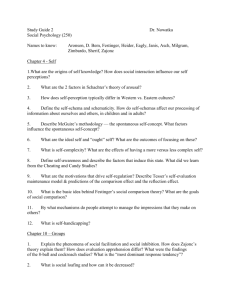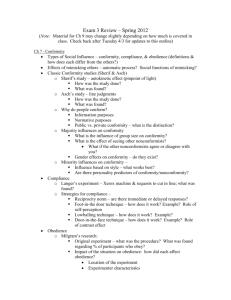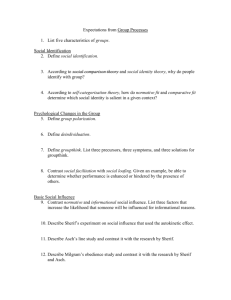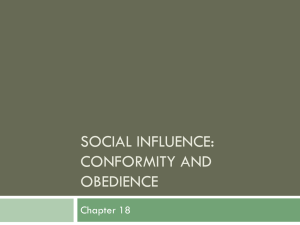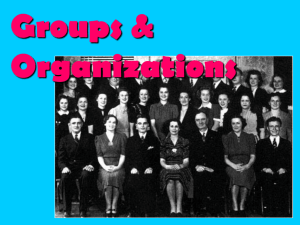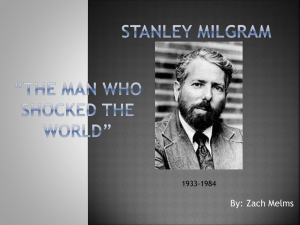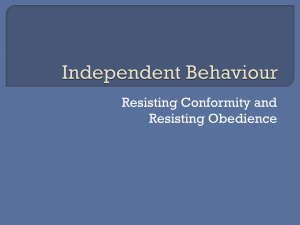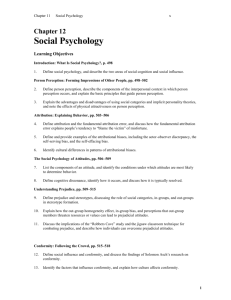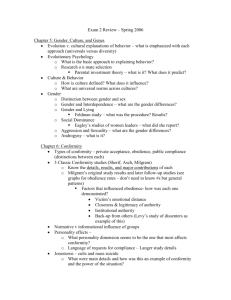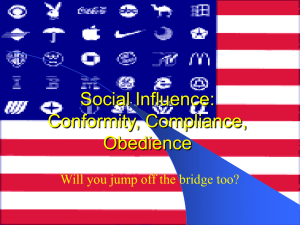Exam 3 Review * Spring 2006 - the Department of Psychology at
advertisement
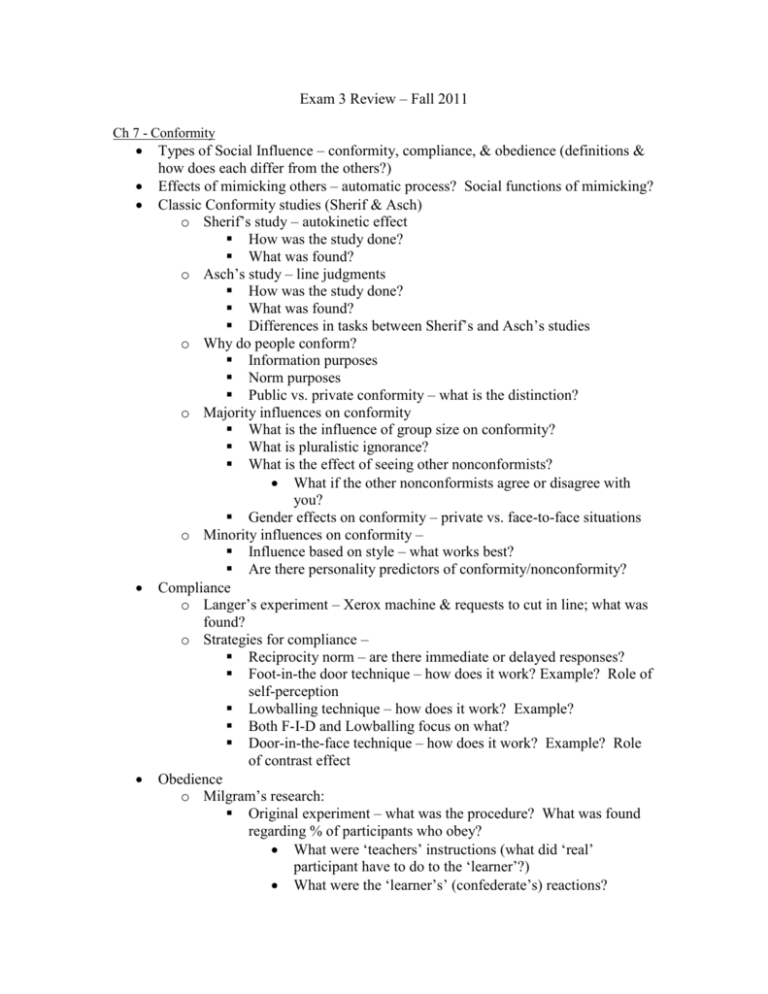
Exam 3 Review – Fall 2011 Ch 7 - Conformity Types of Social Influence – conformity, compliance, & obedience (definitions & how does each differ from the others?) Effects of mimicking others – automatic process? Social functions of mimicking? Classic Conformity studies (Sherif & Asch) o Sherif’s study – autokinetic effect How was the study done? What was found? o Asch’s study – line judgments How was the study done? What was found? Differences in tasks between Sherif’s and Asch’s studies o Why do people conform? Information purposes Norm purposes Public vs. private conformity – what is the distinction? o Majority influences on conformity What is the influence of group size on conformity? What is pluralistic ignorance? What is the effect of seeing other nonconformists? What if the other nonconformists agree or disagree with you? Gender effects on conformity – private vs. face-to-face situations o Minority influences on conformity – Influence based on style – what works best? Are there personality predictors of conformity/nonconformity? Compliance o Langer’s experiment – Xerox machine & requests to cut in line; what was found? o Strategies for compliance – Reciprocity norm – are there immediate or delayed responses? Foot-in-the door technique – how does it work? Example? Role of self-perception Lowballing technique – how does it work? Example? Both F-I-D and Lowballing focus on what? Door-in-the-face technique – how does it work? Example? Role of contrast effect Obedience o Milgram’s research: Original experiment – what was the procedure? What was found regarding % of participants who obey? What were ‘teachers’ instructions (what did ‘real’ participant have to do to the ‘learner’?) What were the ‘learner’s’ (confederate’s) reactions? Impact of the situation on obedience: how did each affect obedience? Location of the experiment Experimenter characteristics Closeness to victim Disobedient others o Reasons for Obeying (in Milgram’s experiment) Were participants conforming to the wrong norm? Self-justification Loss of personal responsibility Zimbardo’s study of prison guards on execution teams o Criticisms of Milgram’s experiment Deception No true informed consent Created distress Did participants know of right to withdraw? Inflicted insight o Resulting ethical guidelines after Milgram’s experiment o Burger’s replication of Milgram How was it similar to Milgram’s experiment? How did it differ from Milgram’s experiment? Results? o Reeder & Pryor’s analysis of Milgram’s follow up with instructions “choose any level of shock you want”…results? o How does the Fundamental Attribution Error relate to Milgram’s study? Jonestown – cults and mass suicide o Relate this example to obedience and conformity o How did the situation play a role in the mass suicide? Ch 8 – Groups Group definition Functions of groups o Social interaction need o Roles within groups – instrumental vs. expressive o Group cohesiveness Groupthink – what is it? Why does it occur? o 8 symptoms – what are each of these? Illusion of Invulnerability Belief in Group’s Moral Superiority Rationalization Stereotypes of Opponents Pressure to Conform Self-Censoring Illusion of Unanimity Mindguarding o How do various ‘symptoms’ above combine to have effects? o How to reduce groupthink? Focus on leadership, decision making, or group members (how?) Group performance o What is process loss and how does it impact performance? Brainstorming example – individuals vs. groups Group polarization – what is it? o Risky shift effect – how does it work? Pooling ideas Social comparison Improving Group Performance o Goal setting effects – what works best? o Technology effects – how can computerized groups be used (what techniques work well?) o Diversity – what are short-term vs. long-term effects of diverse groups? Conflict in Groups o Mixed Motives – lead to social dilemmas Prisoner’s Dilemma (confess/cooperate with partner) Resource Dilemma (commons dilemma with limited resources) Results of these conflict games? o Solutions for social dilemmas? What is a ‘non-zero sum game’ and should dilemmas be viewed this way? Conflict Management Strategies o Bargaining vs. Mediation vs. Arbitration Win-win (integrative) agreements work best How do mediation and arbitration differ? Differences between conventional & final offer arbitration? Group Performance in front of others… o Social facilitation – what is it? Easy vs. difficult tasks – results? Zajonc explanation vs. alternate explanations Social loafing – what is it? Why does it occur? o What is the best solution to reduce social loafing? o Unifying social loafing and social facilitation Deindividuation –what is it? Why does it occur? o Consequences? Ch 9 – Attraction (note that this material may change slightly depending on how far we progress in class through the topics below – check your class notes) Need for affiliation – as individual difference o Compare to loneliness – when does this often occur? Attraction to friendships – o Proximity – how does this predict our friendships? o Mere exposure effect – how does this work? Psych lecture hall experiment Perceptions of ourselves (actual vs. mirror images) o Physical attractiveness Matching phenomenon – how does this work? What effects? Adults’ judgments of kids – teacher study, employee salaries ‘What is beautiful is good’ stereotype – any truth to this? Standards of beauty – women vs. men Evolutionary explanation for such standards? o Liking and similarity Which influences which? 2-step process? Complementarity hypothesis - any evidence for this? First Encounters o Similarity, reciprocity work here o Hard-to-get effect – does this work? Internal vs. external reasons for it? o Where/how do people typically meet? Results of Pew (2005) study? o Online meeting – increasing impact Distinguish between naturally forming relationships, networked relationships, targeted relationships (examples of each?) Initiating relationships online/internet vs. face-to-face o Levinger’s model of relationship development Awareness of other – similar or different in online/face-to-face Surface contact – online vs. face-to-face Mutuality – what does Levinger argue about this stage? o Factors leading to attraction online Person (P) factors – are there differences in who seeks partners online? Other (O) factors – differences in what attracts us to others online? PxO interaction – impact of similarity Matching hypothesis in online relationships – what were results related to compensating factors for men and women (attractiveness vs. income)? Mate Selection o Evolutionary Psych explanations Universal patterns? Female perspective on selecting mates Male perspective on selecting mates Direct Request study – gender differences in % of agreement to request to have sex? Criticisms of evolutionary explanations Exchange perspective to mate selection (deleted 11/7) o Comparison levels o Equity theory Attachment & love o How is attachment studied (infant research) o What are 3 attachment styles? o Links to commitment and satisfaction for each style Theories of love o Passionate/Companionate love – definitions of each Excitation transfer – what is it? Effects? Changes over time in passionate & companionate love Patterns of Marriage o Marital communication Negative affect reciprocity Role of interactions Role of attributions Men are from Mars, Women are from Venus video – main points? Sexual Orientation research o Theories to explain orientation differences o Similarities in research on attraction/relationships Predictors of divorce Satisfaction after divorce
